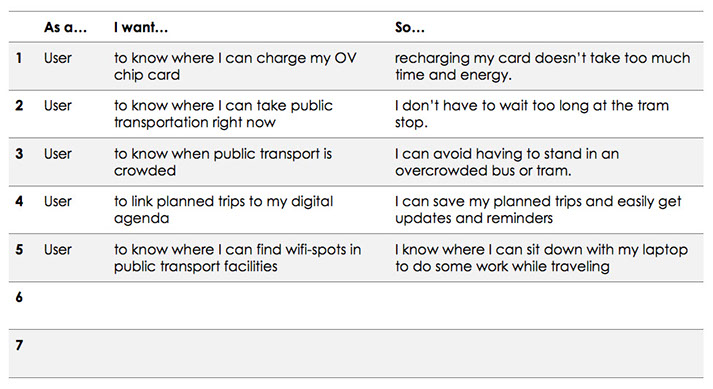User Needs & User Stories
When designing interactive solutions from a human centered perspective focus on describing the needs and goals of the user and then design solutions to fulfill these needs.
What
User needs are goals that (potential) users of a product or system have regarding using this product or system. User stories are the format in which user needs are generally written.
Use when
User needs are collected primarly in the first phases of a design project, when target group analysis takes place. User stories are written before any decisions on technical or design solutions are taken. However, user needs can also come up in any other phase of a project, and important user stories that are identified later on in a project can always be added.
Why
As Jesse James Garrett states in his book The elements of user experience (2011):
“It can be easy to fall into the trap of thinking that we are designing our product or service for one idealized user – someone exactly like us. But we aren’t designing for ourselves; we’re designing for other people, and if those other people are going to like and use what we create, we need to understand who they are and what they need. User needs are the goals for the site that come from outside our organisation – specifically from the people that will use our site. We must understand what our audience wants from us and how that fits in with other goals they have.”
User needs are important because they focus specifically on describing needs and specifically NOT on describing solutions to fulfil these needs. Focussing on needs will force the designer to postpone looking for solutions. This helps to keep an open mind longer, which will lead to more valuable solutions in the end.
How
Identifying user needs is done by executing user research. There are several research methods that can be used to identify user needs, of which non-directive interviews with (potential) users generally get the best results.
User needs are translated to ‘user stories’, short stories that describe the user´s needs. User stories use the following format:
As a
When all user needs are translated to user stories, they are collected in a list of all desired work regarding the development of a product or system: the user story list. Solutions for the user stories will be written in the ‘Required’ column later in the process. These solutions are called ‘Functional requirements’ and ‘Non-functional requirements’.
Examples
As a user
I want to be able to make an appointment online
Benefit: so that I can check my availability in my own time
The above mentioned user story is an example of a story that leaves numerous options for solutions open. Compare this user story to the next on:
As a user
I want to click on a button that opens a form with which I can make an appointment
Benefit: so that I can make the appointment
This second user story doesn’t leave much room for various solutions. Therefore, the first user need is more inspirational for a designer and will lead to better/more valuable solutions.:
An example of a user story list:

Assignment
Make a list of user needs and business requirements (what the client wants) using the user story format, by analyzing the information that is handed to you through the case description.
Write a short argumentation for each user need: based on what information did you decide that this specific user need is important for the website you are going to design?
Further Reading
Must read before class: https://userresearch.blog.gov.uk/2015/05/28/we-need-to-talk-about-user-needs/
Additional knowledge about the value of user stories when working in a team: https://medium.com/@frederik.kraus/do-we-really-need-user-stories-for-effective-software-development-22bb8e58d62d#.5ueb5ywsj
Additional knowledge: https://www.interaction-design.org/literature/article/user-stories-as-a-ux-designer-i-want-to-embrace-agile-so-that-i-can-make-my-projects-user-centered